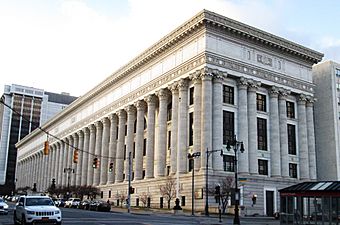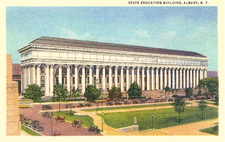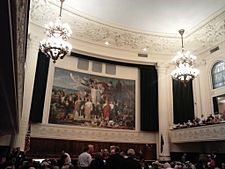New York State Education Building facts for kids
Quick facts for kids |
|
|
New York State Education Building
|
|
|
U.S. Historic district
Contributing property |
|

East profile and north elevation, 2019
|
|
| Location | 89 Washington Avenue (between Hawk and Swan Streets) Albany, New York 12234 |
|---|---|
| Built | 1908-11 |
| Architect | Henry Hornbostel |
| Architectural style | Beaux-Arts |
| Part of | Lafayette Park Historic District |
| NRHP reference No. | 71000521 |
| Added to NRHP | March 18, 1971 |
The New York State Education Building (also known as the State Education Building) is a large government building in Albany, New York. It holds the offices for the New York State Education Department (NYSED). This department helps manage schools and education across the state.
This building was once home to the New York State Museum and the New York State Library. It was designed by Henry Hornbostel in a fancy style called Beaux-Arts. The building opened in 1912 and is famous for its huge row of columns, called a colonnade.
Contents
Building History: How It Was Built
Why Was the Education Building Needed?
The State Education Building was designed by an architect named Henry Hornbostel. It was built between 1908 and 1911. This building was very special because it was the first major building in the United States made just for managing education.
Dr. Andrew Sloan Draper was the first person in charge of education for New York State. He was called the Commissioner of Education of the State of New York. Dr. Draper wanted a separate building for the education department. This would give the growing department more space to work.
Choosing a Location for the Building
In 1906, Dr. Draper worked for two years with the New York State Legislature (the state's law-making group). He managed to get a spot for the new building near the New York State Capitol. This is where the state government meets.
The Education Building cost about $4 million to build. It was finished on January 1, 1911. However, it was officially opened in November 1912. The state museum and library moved into special fireproof parts of the building.
A Fire and a New Home for Books
In March 1911, a fire happened at the Capitol building. This was before the state library's collection could be moved to the new Education Building. Sadly, over 450,000 books and many old papers were lost in this fire. It was a big disaster for the state's history.
In 1959, more work was done on the building. A ten-story addition was built on one side. This new part is called the New York State Education Building Annex.
Recognized as a Historic Place
The building was designed in the Beaux-Arts style. This style was popular for grand public buildings. In 1971, the building was added to the U.S. National Register of Historic Places. This list recognizes important historical places.
The New York State Museum was in the building from 1912 until 1976. Then, the museum moved to the Cultural Education Center. The New York State Library also moved to this new center.
Building Design: What Makes It Special?
The Famous Colonnade
The State Education Building is well-known for its huge colonnade. A colonnade is a long row of columns. The building's application to be a historic place said it has "one of the longest in the world."
According to a group called Emporis, the 36 columns on the front of the building make up the longest colonnade in the United States. These columns are made of hollow marble. They have fancy tops called Corinthian capitals made of terra-cotta.
Inside the Building
The building has a T-shaped design. The famous colonnade forms the top part of the "T." Its Neoclassical style shows how people became interested in this design again after the 1893 World's Fair.
At the entrance, there are two sculptures of children sitting down. These sculptures also work as lampposts. Inside, one important feature is the rotunda. This is a round room that is about 94 feet (29 meters) high. It has a glass and steel dome.
Another special room is the reading room, which is about 50 feet (15 meters) high. It has large arched windows. The rotunda also has curved glass skylights. There is a mural (a large painting on a wall) that shows "man's quest for education." This means it shows how people search for knowledge and learning.
Images for kids





